|
“He said to them: ‘… you will receive power when the Holy Spirit comes on you; and you will be my witnesses in Jerusalem, and in all Judea and Samaria, and to the ends of the earth.’ After he said this, he was taken up before their very eyes, and a cloud hid him from their sight. They were looking intently up into the sky as he was going, when suddenly two men dressed in white stood beside them. ‘Men of Galilee,’ they said, ‘why do you stand here looking into the sky? This same Jesus, who has been taken from you into heaven, will come back in the same way you have seen him go into heaven’” (Acts 1:7-11). Forty days ago, we celebrated the miraculous Resurrection of Jesus from the dead and joyful the start of the Easter season. Finally, after millennia of prophecies and expectation, the promise that humanity would be redeemed and restored in its relationship with God was fulfilled. Now Christ had risen in glory and conquered death by His Passion, allowing humanity to once again be united with its loving Creator (c.f. 2 Peter 1:4). This reunification of the disciples and their beloved Teacher was indeed a cause for celebration! What intense feelings of love and wonder must have resounded in the apostles’ hearts after their Master, Teacher, and Savior had been cruelly put to death only a few days ago. They believed that Jesus’ return meant that He would now “restore the kingdom to Israel” to finish His earthly ministry (Acts 1:6). “Not so, not yet,” Jesus corrects them (c.f. CCC 672). Instead, it was now time for Him to join the Father in Heaven since He had accomplished the Mission of atonement that He had been sent to earth for on the Cross (c.f. John 19:30). With that, Jesus was taken up before His followers into Glory. While they were still watching, whether out of wonder, awe, confusion, or fear as what to do next (perceptibly without Jesus), two heavenly messengers appear and urge the disciples not to stand there, looking up. Jesus would come again, they promised. Meanwhile, there was a mission to undertake; they were to go and wait for the Spirit, Who would help them take the next steps towards completing Jesus’ final instructions, which were, as St. Pope John Paul II put it, “the faithful expression of the Father’s will.” Before He was taken up, Jesus said to the disciples, “All authority in heaven and on earth has been given to me. Therefore go and make disciples of all nations, baptizing them in the name of the Father and of the Son and of the Holy Spirit, and teaching them to obey everything I have commanded you” (Matthew 28:18-20). Christ was planning something bigger than establishing a temporal kingdom on earth, as the Jews commonly thought their awaited Messiah would bring. The Apostles, moreover, were instructed to teach— to proclaim the Good News to the whole world. And they were to baptize in the name of the Father, and of the Son, and of the Holy Spirit. Like Jesus, they were to speak explicitly about the Kingdom of God and about salvation. The Apostles were to give witness to Christ to the ends of the earth. The early Church clearly understood these instructions and the missionary era began. And everybody knew that this missionary era could never end until the same Jesus, who went up to heaven, would come back again. (St. John Paul II, “Homily on the Solemnity of the Ascension of Our Lord,” May 24, 1979) We, too, in a sense, can stand with the apostles, looking heavenward to that place where our Lord ascended. We, too, can experience that intense wonder deep within each of us which transforms fear and tragedy, insecurity and tension into a peaceful certainty that floods the heart with loving warmth from God. From this, the same question posed to the disciples nearly two thousand years ago is asked of each of us even today: why do you stand looking up? The Church’s mission has always been that of the Great Commission, to spread the glorious, joyful, and redemptive news of Christ’s rising from the dead (c.f. John 3:16). As Saint Augustine testified, we are the Church and are commanded to accept this mission and not stand idly by in either amazement or apathy! Certainly, Holy Mother Church’s evangelization has endured obstacles, dogmatic disputes, and other setbacks over the centuries in bringing the Good News to the ends of the earth. No matter the challenge, the Church always pulls through since she has been founded by Christ Himself with the promise that “the gates of the netherworld shall not prevail against it” (Matthew 16:18). As the disciples and the Blessed Mother would experience on Pentecost Sunday, it is the Holy Spirit, the gift of the Father, Who is the source of the Church’s strength. It is He Who guides the Church in the way of Truth in the spreading of the Gospel, doing so through the power of God and not by means of the imperfect wisdom or strength of man. After having undergone the humiliation of His passion and death, Jesus took His place at the right-hand of God; He took His place with His eternal Father. But He also entered heaven as our Head whereupon, in the expression of Leo the Great, the glory of the Head became the hope of the body… our nature is with God in Christ. And as man, the Lord Jesus lives forever to intercede for us with Father. At the same time, from His throne of glory, Jesus sends out to the whole Church a message of hope and a call to holiness. Because of Christ’s merits, because of His intercession with the Father, we are able to attain justice and holiness of life, in him… The power of the glorified Christ, the beloved Son of the eternal Father, is superabundant, to sustain each of us and all of us in the fidelity of our dedication to God’s Kingdom. The efficacy of Christ’s Ascension touches all us in the concrete reality of our daily lives. Because of this mystery it is the vocation of the whole Church to wait in joyful hope for the coming of our Savior, Jesus Christ. (St. John Paul II, “Homily on the Solemnity of the Ascension of Our Lord,” May 24, 1979) As part of the “New Evangelization,” we are reminded of this command to reveal the Truth of our resurrected Lord through our words and actions in accordance with how we are called to live as Christians, that is, with love (c.f. John 13:34-35). Like the evangelizers before us, we can expect face challenges when spreading the Gospel message, namely persecution (c.f. John 15:18, Romans 8:35-39, 2 Timothy 3:12, 1 Peter 4:16-19). Ah, but what a price to pay for the glory of God! Remember, too, that Christ promised that He would always be with us in our ministry (c.f. Matthew 28:20, Galatians 2:19-20)! As Pope Francis noted during his fourth general audience, Jesus is no longer “in a definite place in the world as He was before the Ascension… He is now in the lordship of God, present in all space and time, next to each of us.” We can always turn to Him in prayer; He, in turn, will sustain us with strength, grace, and Love. Given the difficulty of our task (often requiring great sacrifice on our part), this is indeed a great comfort! In addition, it is Christ as both God and man Who brings our humanity before God to intercede for us. Finally, the Ascension of the Lord is also our Feast because we have ascended with the Lord! The Feast presents an opportunity to reflect upon the relationship between our profession of faith and our daily life. It is the start of the evangelization of the world by Christ’s disciples and the call for us to do that same Work, started nearly two millennia ago, in joyful witness to the Redeemer of the world. The Solemnity of the Lord’s Ascension must also fill us with serenity and enthusiasm, just as it did the Apostles who set out again from the Mount of Olives “with great joy” (Luke 24:52). Like them, we too, accepting the invitation of the “two men in dazzling apparel”, must not stay gazing up at the sky, but, under the guidance of the Holy Spirit must go everywhere and proclaim the saving message of Christ’s death and Resurrection. His very words, with which the Gospel according to St Matthew ends, accompany and comfort us: “and lo, I am with you always, to the close of the age” (Matthew 28:20). (Pope Emeritus Benedict XVI, “Homily of His Holiness During the Pastoral Visit to Cassino and Monte Cassino,” May 24, 2009) Thomas Wong is an undergraduate at The Catholic University of America, currently studying abroad in Rome, Italy.
0 Comments
“Fall in Love, stay in love,
and it will decide everything.” (attributed to Fr. Pedro Arrupe, SJ) In college, discernment was easy. “Discernment” meant prayer and discussing possible vocations with friends and spiritual guides. The experiences cemented friendships and built spiritual foundations that will hold me throughout life. However, I found that discernment is truly practiced when we make a decision and carry it out. At the end of my undergraduate career, the time came to make important decisions about what to do after graduation. At the moment of making a big decision, I looked back at the small decisions made in the past few years. How did I choose groups of friends, extracurricular activities, or even classes? To my mind came the prayer quoted at the beginning of the post. To quote it in full: “Nothing is more practical than finding God, than falling in Love in a quite absolute, final way. What you are in love with, what seizes your imagination, will affect everything. It will decide what will get you out of bed in the morning, what you do with your evenings, how you spend your weekends, what you read, whom you know, what breaks your heart, and what amazes you with joy and gratitude. Fall in Love, stay in love, and it will decide everything.” This time, my discernment led me to conclude three things with which I have come to love in a quite absolute, final way: God, service, and math. My schedule consistently prioritized these three, and throughout my senior year, I saw that God opened doors for me. I had options, but this also meant I had to make a decision. Through the Alliance for Catholic Education (ACE) program at the University of Notre Dame, I made my way to sunny Jacksonville, Florida where I am teaching high school mathematics. Denial in discernment was comfortable because it allows us to remove the panging doubts that come with making decisions: How will I know if I made the right one? One message that is clear from the Gospels is that God is always with us, and He will let us know when we are on the right track. Jesus says, “It was not you who chose me, but I who chose you and appointed you to go and bear fruit that will remain,” (Jn 15:12). My first confirmation that God chose ACE for me was the moment I found out I was accepted. As I read through the email, joy and excitement came bursting out in a series of shouts, hollers, and jumps. Looking back, that extreme emotion did not have its source in me or an email but solely in God. Other signs came, but from that moment of acceptance I had confirmation that I was putting my feet on the correct path. Now, with a year of teaching under my belt, I can list the further confirmations that this is God’s plan for me. As I read through the prayer above, I think of how teaching mathematics in a Catholic school has seized my life. I get out of bed to meet with the student who needs to review before a test, and I choose to spend many evenings and weekends excitedly planning my lessons or meeting the grim realities in grading. My free time is consumed by reading over teaching blogs or swapping lesson plans with colleagues. Now what breaks my heart is the student who has barely passed his previous math courses and continues to flounder in mine despite his best efforts. Now I am amazed in gratitude when a student is able to lead the class in prayer. Though I still have a year of teaching left with ACE, I know the time for more decisions will be here soon. This realization has led me to more fully understand another essential nature of discernment: it never ends. Fortunately, we can take part in continual discernment because we have a God who continually acts. What is He making me notice today? What seized my attention this week? Where have I felt moments of great joy this year? “Fall in Love, stay in Love, and it will decide everything.” Tim McEvoy is a teacher through the Alliance for Catholic Education in Jacksonville, FL. John: 15:9-11: As the Father loves me, so I also love you. Remain in my love. If you keep my commandments, you will remain in my love, just as I have kept my Father’s commandments and remain in his love. “I have told you this so that my joy might be in you and your joy might be complete.” In today’s Gospel, we are given a clear picture of how we can live life in the joy of Christ. In order that our “joy might be complete”
Jesus tells us that we must imitate his love for the Father. Furthermore, Jesus references clear and simple guidelines on how to remain in his love, the commandments. In my own life, I believe the key here is the need for us to imitate Christ. We often say that imitation is the highest form of flattery, and that could not be more true. Our goal should be union with God in heaven and the easiest way to achieve that union is by living a Christ-like life. Christ already loves us dearly, but how enamored is he when he sees us loving as he taught us! Christ yearns to be in relationship with us, for us to know him by loving like him. Mother Teresa had a beautiful devotion to Christ on the cross. When he exclaimed, “I thirst,” she interpreted this as Christ’s thirst for souls. He has an intimate longing for each of us to “remain in his love,” to know him and to love him. Therefore, when we imitate the love of Christ, we not only acknowledge the truth of his actions, but also are called to further relationship with God. It is crucial for us to remain in Christ’s love and in relationship with him because we thirst for him as well. Our world longs for perfection and satisfaction, but we will never be able to achieve this as the world sees it. The perfect body, the perfect job, the perfect grades, house, family, car – none of these can satisfy us like we often think it will. Christ knows this because he knows us intimately – “You formed my inmost being; you knit me in my mother’s womb” (Ps 139:13). He did not merely make us for this short life on earth – Christ made us to live eternally with him in heaven! Christ calls us to live this calling as citizens of heaven and to follow his commandments so that we may know him and his infinite joy. Let us pray with St. Paul that we may not be conformed to this age, but that we may be transformed by the renewal of our minds to the way of heaven, that we may discern what is the will of God, “what is good and pleasing and perfect” (Romans 12:2). In conforming ourselves to Christ, in imitating his actions of love to all people and to the Father, by obeying the commandments laid out before us, we are called to be in relationship with him and thus take a most important step on the journey toward our salvation. It is important that we recognize the examples around us in Mother Teresa, St. John Paul II, our mothers and fathers, but it is also important to recognize that their holiness and their passion for the Lord steps from an imitation of Christ’s life. As the Easter season comes to a close in the next couple weeks, let us make a concerted effort to imitate Christ’s love and to conform ourselves to him. Nicholas Shields is a graduate of The Catholic University of America with a degree in Mathematics. Transitions can sometimes be the hardest part of our lives. Often, transitions are filled with hope and anticipation, but other times they are filled with fear and anxiety. The transitions I’m currently thinking of include moving, new jobs, graduation, marriage, children, losing a loved one, and many more. Everybody's lives change, both in good times and in more difficult ones; the key is figuring out how to maneuver through those changes and create new beginnings.
Transitions often change our faith-based routines. Prayer, Mass times, and proximity to a Church are the top contenders for what may be lost or overlooked in these fearful times of anticipation and uncertainty. What we forget is that prayer and dependence on Christ are the most important things to hold onto. As Psalm 77: 1-2 says, “I cry aloud to God, aloud to God, and he will hear me. In the day of my trouble I seek the Lord…” When we are afraid or in trouble, God is there. He is there in the easy and joyful transitions, too, waiting for gratitude and recognition. Our faith is the vehicle by which our lives are maneuvered. All of life’s stop signs and road blocks, in each pit stop and flat tire, in every new paint job and deep clean, Christ is there as our GPS if we let him. No matter how long it takes to recalculate our journey through transitions, God is with us and wants us to ask for guidance. I have recently graduated from college, a time that brings many changes. In our commencement address, we received one solid takeaway: nunc coepi, which is Latin for, “Now I begin.” I’m realizing, as did our incredible Catholic speaker, that in all of life’s transitions, nunc coepi is applicable. If during life’s stop signs, we say, “nunc coepi,” we can continue with our job searches. If at a financial roadblock, we say: nunc coepi, recognizing that God will provide and make sure the bills are paid. It can be a simple phrase that helps us recognize the blessings, and continue on with whatever God’s plan for happens to be. The faith behind the phrase nunc coepi shows faith in God’s plan for each of us, and through each of life’s transitions. My favorite verse in the Bible comes from the moment that Gabriel tells Mary that she has been chosen to be the Mother of Jesus, and says in Luke 1: 37-38, “Fear not! For nothing will be impossible with God.” And then Mary responds with, “Behold, I am the handmaid of the Lord, let it be done to me according to Thy Word.” Like Mary’s response to her own life-changing moment, can we say “Yes” to God? Can we, in our own transitions, continue to say, nunc coepi? Now I begin. Krissy Kirby is a graduate of The Catholic University of America with a degree in Early Childhood Education. Being a “cradle Catholic” I never questioned why we had 4 different statues of Mary in our kitchen or why every May we put a crown of flowers on our “Garden Mary” outside. It was common to hear the advice of praying to the rosary if you couldn’t sleep and thus one would be able to find countless glow-in-the-dark rosary beads tucked into my bed. Almost every woman in my family had Marie as their middle name and like myself, if it wasn’t a middle name it was taken as a confirmation name. It wasn’t until college, living under the shadow of “Mary’s House”, the Basilica of the Shrine of the Immaculate Conception in Washington DC, that I began to understand that it was through Mary that I would come to know her Son. St. Vincent Pallotti understood this and had a deep connection with Our Lady and entrusted himself to her. He wrote “I resolve, my God, from all eternity and for all eternity . . . to love, honor and glorify my beloved Mother Mary; and to behold her loved, honored and glorified to the same degree that You, O Eternal Father, have showered her as Your Daughter, that You, O Divine Lord, have esteemed her as Your Mother, and that You, O Holy Spirit, have accorded her as Your most pure spouse.” (Soul of a Saint, p. 82) His devotion went beyond the pious practice of the time and enlightened a burning love within him. He spoke of Our Lady as, “Mother of Divine Love” and “Queen of Apostles.” It is said that he spoke, “I shall not rest until I, if this is possible, have achieved an infinitely tender love for my much beloved and much loving mother, Mary.” St. Vincent, in his deep love for Mary and a desire to be humble, work a silver reliquary box around his wrist with the image of the Mother of Divine Love painted on ivory mounted on it. He did this so that when people came to kiss his hand, a practice of that time, instead of kissing how own hand they would instead kiss the image of Our Lady. During this Month dedicated to Mary, let us look to St. Vincent as an example of how a love for our blessed mother can help us in reviving faith, enkindling charity and become an apostle of Christ. Pam Tremblay is a Collaborator with the Catholic Apostolate Center Prayer to Mary Queen of Apostles
This past Sunday, we celebrated Mother’s Day. This is an important day to remember the important role that our mother and mother-figures play in our lives. From aunts to grandmothers to friends, we all have many women in our lives that we can look up to. In my own life, my mother is a constant source of inspiration to me. Giving up a successful career to stay home with my siblings and I was a sacrifice she made joyfully. Raising the four of us could not have been an easy task, and I will always appreciate the happy home she created for all of us to come home to each day. She formed our faith and gave us the tools to go out and live that faith in our own individual ways.
One of the ways in which I enjoy participating in my faith is through serving masses at the Basilica of the National Shrine of the Immaculate Conception. This Basilica is dedicated to the Blessed Mother, and throughout the entire building you can wander through chapels dedicated to her many titles. One of the priests of the Basilica always welcomes visiting pilgrimage groups with a short message about how if we let the Blessed Mother into our lives, she will bring us closer to her Son. He reminds each visiting group that by allowing Mary a place in our hearts, she will teach us and help us grow in our faith. On Mother’s Day this is a particularly applicable message as we remember our own mothers as well as the Blessed Mother. Mary has a unique place in the Catholic faith. She is the Mother of God, born without sin, yet still one of us. Her willingness to say “yes” to God’s calling is one which we try to emulate in our lives every day. Mary demonstrates the important role a mother plays in their child’s life, even if that child is the Son of God. We see her gentle guidance in Jesus’ formative years, and it was through Mary’s prompting that Jesus performed his first miracle at the wedding in Cana. Through Mary’s “yes” to God we are also reminded of the importance of answering our own vocations. Although it is often difficult to find our place in this world, the example of the Blessed Mother reminds us that saying “yes” is the greatest choice we can make. As we have spent this past weekend celebrating the mothers in our lives, let us also remember the special place that the Blessed Mother has in our faith. She can help us find and say yes to God’s calling in our own lives. I will leave you with one of my favorite prayers to Mary: The Memorare: Remember, Oh Most Gracious Virgin Mary. That never was it known, that anyone who fled to thy protection, implored thy help, our sought thy intercession was left unaided. Inspired by this confidence I fly unto you, Oh Virgin of Virgins, my mother. To thee I come, before thee I stand, sinful and sorrowful. Oh Mother of the Word Incarnate, despise not my petitions, but in thy mercy, hear and answer me. Amen. Rebecca Ruesch is the Blog Editor for the Catholic Apostolate Center The belief that faith and reason are complementary ways of coming to know the truth, rather than antagonistic rivals or competitors for one’s allegiance, has its foundation in the NT itself and, ultimately, in a person rather than a text.
When the earliest of Christian writers were searching for ways in which to articulate the meaning of what we might call the “Jesus Event,” i.e., the life, death and resurrection of Jesus of Nazareth, one of the first associations they made was between Jesus and the ‘wisdom’ [σοφία] or ‘reason’ [λόγος] of God. Drawing from the book of Wisdom, St. Paul refers to Christ as “the wisdom [σοφίαν] of God” (1 Cor 1:24). “All things were created through him and for him,” the Apostle states elsewhere, “He is before all things, and in him all things hold together” (Col 1:16-17). These latter remarks about Jesus, the identification of him with God’s divine wisdom, NT scholars agree pre-date St. Paul himself. They were, most likely, part of a hymn to Christ which the early Christian community used in their liturgical services. Thus, from the very beginning of Christianity, before the composition of the NT, Christians understood Jesus as the incarnation, the en-fleshment, of God’s divine wisdom; the wisdom by which God created, governs and sustains the natural world. The living embodiment of the ‘plan’ (ratio) according to which the cosmos was designed and functions. A bit later in Christian history, around the year 90, this belief was given its classic expression in the prologue to St. John’s Gospel: “In the beginning was the Word [λόγος], and the Word was with God, and the Word was God. He was in the beginning with God. All things came to be through him, and without him nothing came to be” (Jn 1:1-3). The Greek term for ‘Word’ [λόγος] in this translation can have many meanings: word, speech, language, an account or narrative, or an explanation. It can also mean, most importantly, ‘reason’ or ‘thought.’ So if we exchange translations, we can read the same passage as: “In the beginning was Reason and Reason was with God, and Reason was God. He was in the beginning with God. All things came to be through him, and without him nothing came to be.” With his obvious linguistic allusion to Genesis 1:1 [i.e., “In the beginning…”], the author of the prologue is affirming the divine nature of God’s reason and wisdom. A few verses later, of course, the author takes the further step of associating this Reason with the person of Jesus: “And the Word [Reason] became flesh and made his dwelling among us” (Jn 1:14). For the Catholic, then, as true now as was for these early Christian authors, it is in God, and especially through the person of His Son Jesus Christ, that Wisdom, Reason and Truth have their being. As Jesus said: “I am the way the truth and the life” (Jn 14:6) and “for this I was born and for this I came into the world, to testify to the truth. Everyone who belongs to the truth hears my voice” (Jn 18:37). Understanding that the world was created according to divine reason, and that the seeds of reason are to be found in the entire created order, the Catholic tradition has long affirmed the human capacity, and supported the human effort, to discover truth in the natural world by the light of human reason. It is true that the early Christian theologian Tertullian famously asked the question: “What has Athens to do with Jerusalem?” (De praescr. haeret. 7). But on that matter, and quite a few others, Tertullian was departing from the established Christian thought of his time. The Catholic tradition, on the other hand, acknowledges that since truth cannot be opposed to itself, the truths of the faith cannot contradict those of science or reason (cf. Aquinas SCG 1.7). Faith and reason are not competitors, but the two complementary ways in which humankind might come to know the truth. This point has been articulated throughout the Catholic intellectual tradition and, more recently, the Second Vatican Council stated that “methodical research, in all realms of knowledge, if it respects […] moral norms, will never be genuinely opposed to faith: the reality of the world and of faith have their origin in the same God” (GS § 36). Likewise, Pope St. John Paul II stated that faith and reason are two complimentary ways of coming to the truth because “the unity of truth is a fundamental premise of human reasoning, as the principle of non-contradiction makes clear” (FR § 34). The mutual necessity of both faith and reason is nowhere more evident than in the discipline of theology. In examining the application of reason to matters of faith, St. Augustine once wrote: intellege ut credas, crede ut intellegas (‘to understand so that you might believe, to believe so that you might understand’) (s. 43.9). More than half a millennium later, the Benedictine archbishop of Canterbury, St. Anselm, meditating on St. Augustine’s thought, would famously define theology as fides quaerens intellectum (‘faith seeking understanding’) (Cf. Pros. 1-2). In attempting to sum up this intellectual inheritance, this particularly Catholic way of viewing, inter alia, the relationship between faith and reason, many writers have taken to calling this hermeneutic the Catholic “both/and.” As opposed to looking at the world and seeing a multitude of choices which demand an “either/or” decision, the Catholic “both/and,” being sensitive to false dichotomies, sees the value – and in many instances the necessity – of each choice: nature and grace, action and contemplation, freewill and providence, invisible grace and material signs, and, of course, faith and reason. From the Catholic perspective, therefore, the relationship between faith and reason has never been an antagonistic one. Rather, the Catholic sees the proper use of one’s intellect as an activity which draws us nearer to God by seeking His Wisdom. Anthony Coleman teaches theology for Saint Joseph’s College Online This blog post was originally published on the St. Joseph’s College of Maine Theology Faculty Blog. Click here to learn more about our cooperative alliance with St. Joseph’s College Online. A few nights ago, I had the great joy of attending my final university-wide Mass as an undergrad at The Catholic University of America. The Church was packed for this 9pm liturgy, and it ended with a final blessing of the graduates. Amidst my tears as I looked out to the full chapel, I was overcome with gratitude for the ways that God has worked in my life the last four years. Above all, I was overwhelmed with the reminder that God is bigger.
Life isn’t always easy, that’s for sure. And I’ve definitely had my fair share of difficulties these past four years. College is one big learning curve – classes, friendships, discernment about the future, and wondering how much caffeine your body can really hold. I have learned so much about myself and my relationships with others, but more importantly I have joyfully resigned myself to the fact that no matter the difficulties, God is bigger than anything that we face. God is bigger than the 3 a.m. writer’s block, bigger than the failed friendship, and certainly bigger than our own human weaknesses. We are steeped in a world that tries to tell us that we can do it on our own—that we don’t need each other and that we definitely don’t need God. The reality is this—none of my successes or failures over these last four years have been done on my own, and nothing I hope to accomplish in the future will be on my own. I have been blessed with an incredible community of family, friends, teachers, and spiritual mentors who have encouraged and supported me in ways that I don’t deserve. But most importantly, I have been graced with the knowledge that we serve a God who is bigger than all of it. It is all too easy to get caught up with day-to-day minutiae, to become so concerned with what is happening in our own lives that we forget to take a step back and remember that we aren’t the ones who are really in control. I know in my own life I often focus on the difficulties in the world around me and in the lives of those that I love instead of remembering that the promise of the Incarnation is that God chooses to never leave us. He is bigger than our relationship problems, bigger than our sin, bigger than life’s difficulties, bigger than the sad stories that we hear on the news, and bigger than anything we have planned. Most days I’m overwhelmed with this knowledge, and overwhelmed with gratitude that the promise He made to His disciples 2000 years ago to “remain with us always, even until the end of the age” still rings true for us today. God is bigger, and He is a mighty God indeed. Lauren Scharmer is a senior at the Catholic University of America studying Social Work & Theology and is active in both retreat and youth ministry in both the Archdiocese of Washington, D.C. and Diocese of Arlington. 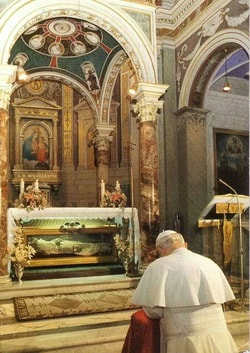 "John XXIII and John Paul II cooperated with the Holy Spirit in renewing and updating the Church in keeping with her pristine features, those features which the saints have given her throughout the centuries." - Pope Francis This past Sunday was a unique and amazing day of four popes, the two pope saints, John XXIII and John Paul II and the two living popes, Pope Francis and Pope Emeritus Benedict! The renewal and updating of the Church called for by the Second Vatican Council, initiated by St. John XXIII, and central to the work of the New Evangelization as articulated by St. John Paul II continued through the efforts of Pope Emeritus Benedict XVI, especially the Synod on the New Evangelization and finding even greater momentum through the witness of Pope Francis. Among them all, along with Paul VI, the Council, and Church leadership in general has called all of the baptized to engage in greater co-responsibility for the life of the Church and for the work of evangelization. Various pundits, both in Church and secular media, are quick to give their sometimes very simplistic analysis of why the two popes were canonized together and the message that Pope Francis is trying to convey. If there is any "message", I believe that it is a continued or re-commitment to the on-going renewal of the Church in trustful cooperation with the Holy Spirit and in prayerful communion with the saints. St. John XXIII and St. John Paul II were both visionary leaders who put forward programmatic plans for not simply renew of the Church as an institution, but renewal of all the baptized in faith and holiness who are called to go forth to the world and renew it as well. In 1959, St. John XXIII said, "Profession of the Christian faith is not intelligible without strong, lively apostolic fervor" (Princeps Pastorum, 32). The Second Vatican Council confirmed this understanding in Lumen Gentium through its teachings about the Universal Call to Holiness and the role of all the baptized in the mission of Christ. St. John Paul II was one of the drafters of the Decree on the Apostolate of the Laity (Apostolicam Actuositatem) along with the then Rector General of the Society of the Catholic Apostolate, Fr. Wilhelm Möhler. St. John Paul taught in his apostolic exhortation Christifedles Laici, which followed the Synod on the Laity in 1987, that The Second Vatican Council has reminded us of the mystery of this power and of the fact that the mission of Christ - Priest, Prophet-Teacher, King - continues in the Church. Everyone, the whole People of God, shares in this threefold mission (14). Just after the close of the first session of the Council, St. John XXIII canonized the Patron of the Catholic Apostolate Center, St. Vincent Pallotti, calling him "an innovator of new ways whereby people could come to know the love of God" (Cf. L'Osservatore Romano, January 23, 2013). Pallotti understood well the call of all to be apostles or what Pope Francis calls in Evangelii Gaudium, "missionary disciples" (120). The Center continues Pallotti's mission in the way that St. John Paul II described it to members of the Union of Catholic Apostolate when he said: Continue to multiply your efforts so that what Vincent Pallotti prophetically announced, and the Second Vatican Council authoritatively confirmed, may become a happy reality, and all Christians become authentic apostles of Christ in the Church and in the world! (Homily at San Salvatore in Onda, June 22, 1986). Mary, Queen of Apostles, pray for us! St. Vincent Pallotti, pray for us! St. John XXIII, pray for us! St. John Paul II, pray for us! Fr. Frank Donio, S.A.C., is the Director of the Catholic Apostolate Center |
Details
Archives
July 2024
Categories
All
|
About |
Media |
© COPYRIGHT 2024 | ALL RIGHTS RESERVED

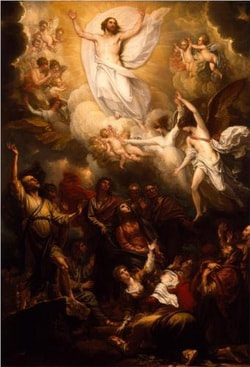

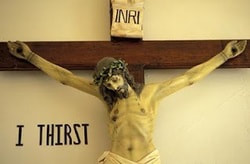
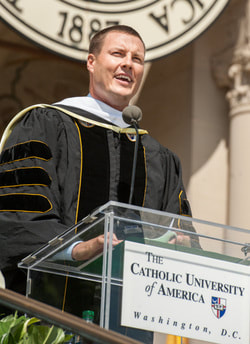
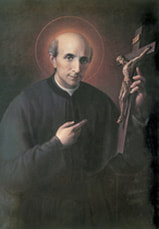
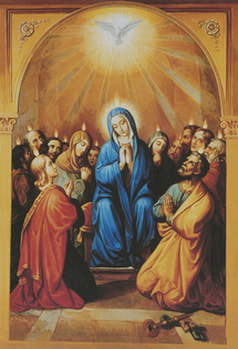
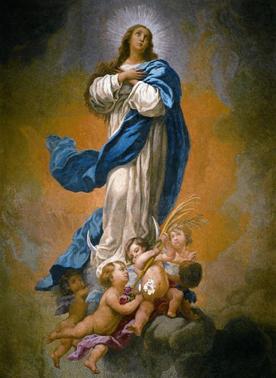


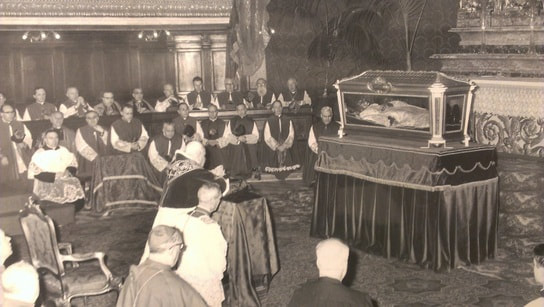
 RSS Feed
RSS Feed